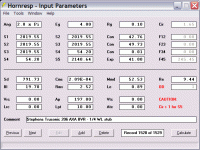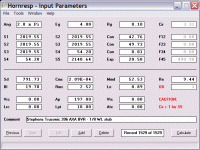I'm curious as to what's used to model and design a BVR cabinet for a particular driver. It's either that, a reflex/onken or a MLTL.
In this case, the driver is my single trusty Stephens Trusonic 206 AXA 15" coax. I was considering a corner cabinet, which naturally lends itself to BVR (Qts appears a bit high for true rear horn loading)
T/S measured using a Dayton WT3 are
D 317.5 [mm]
Re 9.44 [Ohms]
Fs 43.07 [Hz]
Zm 163.30 [Ohms]
BL 19.56 [N/A]
Qms 7.009
Qes 0.430
Qts 0.405
Vas 186.700 [liters]
L10k 0.89 [mH]
n0 3.31 [%]
dBSPL 97.30 [1W/1m]
Ms 64.39 [grams]
Cms 0.21 [mm/N]
I have a licensed copy of Martin King's worksheets in case they can be used (perhaps the double mouth horn sheets??).
Thanks
In this case, the driver is my single trusty Stephens Trusonic 206 AXA 15" coax. I was considering a corner cabinet, which naturally lends itself to BVR (Qts appears a bit high for true rear horn loading)
T/S measured using a Dayton WT3 are
D 317.5 [mm]
Re 9.44 [Ohms]
Fs 43.07 [Hz]
Zm 163.30 [Ohms]
BL 19.56 [N/A]
Qms 7.009
Qes 0.430
Qts 0.405
Vas 186.700 [liters]
L10k 0.89 [mH]
n0 3.31 [%]
dBSPL 97.30 [1W/1m]
Ms 64.39 [grams]
Cms 0.21 [mm/N]
I have a licensed copy of Martin King's worksheets in case they can be used (perhaps the double mouth horn sheets??).
Thanks
Big vent reflex
Hi Zobsky. I always use horn response as you can set it like the big vents I
have seen here with the first small part of the vent parallel and then a short flare. Seems to need a bass reflex type box or maybe even slightly larger.
There was a guy used to come to this site who modeled more horn shaped
boxes, no parallel sides and had what appears to be a rule of thumb spreadsheet. He said he used about 10% larger than normal bass reflex
cabinet.
I supposed that if you modeled a reflex where the cabinet size needed a very long vent, this might work.
jamikl
Hi Zobsky. I always use horn response as you can set it like the big vents I
have seen here with the first small part of the vent parallel and then a short flare. Seems to need a bass reflex type box or maybe even slightly larger.
There was a guy used to come to this site who modeled more horn shaped
boxes, no parallel sides and had what appears to be a rule of thumb spreadsheet. He said he used about 10% larger than normal bass reflex
cabinet.
I supposed that if you modeled a reflex where the cabinet size needed a very long vent, this might work.
jamikl
(Qts appears a bit high for true rear horn loading)
And yet the math implies something quite different to me. 😉 Regardless, just 'running the numbers', a pair of Classic BVR alignments, so play with different vent dims using a parabolic flair if you want a slope board construction (two parallel, one sloped):
GM
Attachments
And yet the math implies something quite different to me. 😉
GM
Details, please, GM ? EBP is around 100
Thanks
Last edited:
Like GM, the math implies something rather different to me too... 😉
As a general observation, don't get bogged down with EBP. It's so over-approximated as to be practically worthless & some of the basic assumptions often made with it can be downright misleading.
As a general observation, don't get bogged down with EBP. It's so over-approximated as to be practically worthless & some of the basic assumptions often made with it can be downright misleading.
Last edited:
Agreed, though I wouldn't call it worthless since without it I probably wouldn't have been able to 'crack the code' for coming up with my various 'Simple Simon' TL, horn calculators and wish there had been a similar one to account for their impact on vent design which for me is where MJK's and others calculators true worth lies. Before EBP, all my tower (MLTL), pipe horn designs were larger than required due to being derived from simple, 'worst case' design nomographs that dictated near IB size cabs for a low tuning.
Then again, in mine and some others opinions the larger cabs have a somewhat more effortless/life-like sound Vs the much more tightly constrained T/S alignments, so I guess the knowledge is a mixed blessing overall.
GM
Then again, in mine and some others opinions the larger cabs have a somewhat more effortless/life-like sound Vs the much more tightly constrained T/S alignments, so I guess the knowledge is a mixed blessing overall.
GM
I stand corrected, 'worthless' was a bit OTT of me.
I know what you mean about the boxes; whatever it is, the bigger options usually work for me.
I know what you mean about the boxes; whatever it is, the bigger options usually work for me.
Last edited:
- Status
- Not open for further replies.
- Home
- Loudspeakers
- Full Range
- Big Vent Reflex - How to design one

